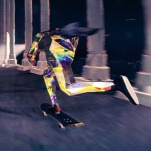Each week, Big Issues focuses on newly released comic books of significance. This week, they are A&A: The Adventures Of Archer And Armstrong #4, written by Rafer Roberts with art by David Lafuente, inker Ryan Winn, and colorist Brian Reber, and Wrath Of The Eternal Warrior #8, written by Robert Venditti with art by Raúl Allén and Patricia Martín, assistance by David Astruga, and additional colors by Borja Pindado. These two issues are prime indicators of how Valiant has grown as a publisher since its revival four years ago. (Note: This review reveals major plot points.)
While Marvel and DC have been churning out relaunches and events for the last four years, Valiant has been building an impressive lineup of titles and creators, releasing consistently entertaining superhero comics that offer an engaging alternative to the Big Two. Valiant’s output becomes more ambitious and distinct with each passing year, and this is the best week Valiant has ever quality-wise. Granted, Valiant is only publishing two comics (weekly releases are capped at three titles) so it’s easy for it to have a good week, but A&A: The Adventures Of Archer & Armstrong #4 and Wrath Of The Eternal Warrior #8 bring a new level of craft, imagination, and personality to Valiant Comics.
A&A and Eternal Warrior are two very different series. The former is a madcap buddy comedy jam-packed with jokes and visual gags, while the latter is a brutal genre-bending action thriller—but they share a strong connection via their immortal leads. A&A’s Armstrong and Eternal Warrior’s Gilad are brothers, and while their current series have yet to capitalize on this bond, the two books have both found immense success by focusing on the passage of time and how these undying characters relate to it. The emotional core of A&A is Armstrong’s relationships with his partners past and present, and his guilt regarding his asshole behavior to his old companion, Frank, leads to the alcohol-soaked insanity that Archer, Armstrong, and Mary-Maria endure in this opening arc. Eternal Warrior gains its emotional weight from Gilad’s relationships with all the mortal family members he’s lost during his time as the Earth’s immortal defender, and the current storyline has him revisiting those souls in the afterlife over and over again as he’s repeatedly killed.
Writers Rafer Roberts (A&A) and Robert Venditti (Eternal Warrior) use these characters’ expansive histories to fuel their narratives, and they understand that the millennia of personal experience these characters have gathered open up loads of storytelling opportunities. Armstrong was around during ancient Rome and he’s an established party animal, so it makes a strange kind of sense for Roberts to set up the Roman party god Bacchus as one of Armstrong’s oldest enemies. This initial A&A storyline began with Armstrong venturing into his bottomless satchel to find a cherished bottle of booze, and sending the character into a bag full of artifacts from his past is a handy metaphor for his emotional journey in these issues as he’s overwhelmed by past regrets. Armstrong comes to terms with those regrets in this week’s conclusion, but this deeper character development is paired with a chaotic, hilarious action sequence that keeps humor at the forefront of the series.
The title of Wrath Of The Eternal Warrior works as a concise summary of the book’s concept. He’s a warrior that can’t die, and he’s really pissed off. “Wrath” is a powerful word, and each of Venditti’s storylines builds to Gilad unleashing his rage and anger on those that have made him and his loved ones suffer. The first arc had Gilad making his way out of the afterlife by cutting through hordes of demons trying to prevent his revival, a vicious journey balanced by the tenderness of Gilad’s interactions with his family. The prologue to the current “Labyrinth” arc was a flashback to Gilad murdering the men who killed his wife and kidnapped his firstborn son in ancient Mesopotamia, once again balancing brutality with personal intimacy.
This week’s Eternal Warrior issue ends with present-day Gilad finally getting the upper hand in his ongoing conflict with the man who has imprisoned him in a technologically advanced labyrinth, and after suffering a rapid succession of deaths over the course of many weeks, Gilad is ready to make his captors feel his wrath. Violence for the sake of violence isn’t all that intriguing, even if it’s beautifully illustrated as it is in this title, but Venditti has done excellent work providing an emotional impetus for all that action, making Gilad more interesting than he’s ever been in the process.
As engaging as the writing is on these series, what really elevates them to greatness is the artwork. Artists David Lafuente (A&A) and Raúl Allén and Patricia Martín (Eternal Warrior) are doing some of the most bold, original work in all of superhero comics right now, and most of that innovation comes from how they depict the passage of time. That’s a key element in both of these titles, and both art teams are eager to explore temporal dynamics on the page in exciting ways. Lafuente’s work on A&A #4 focuses on decompressing time with extremely dense layouts that break down the action into a multitude of small panels that slow down the reading experience, forcing the reader to spend more time on each page because there’s so much visual information being presented. His layouts share more in common with the work of Chris Ware than any superhero artist, and it’s fascinating to see how Lafuente uses this design sensibility to interpret the action and comedy in Roberts’ script.
The above 22-panel page is an excellent example of how Lafuente uses these layouts to control the flow of the narrative, beginning with a single panel across the full width of the page that serves as a transition between the more relaxed layouts of the preceding pages and the pandemonium that Archer, Armstrong, and Mary-Maria are throwing themselves back into. The increased number of panels reflects that change in atmosphere, but all those extra panels also work to tightly control the pacing.
Take those second two rows: The sequence begins with a close-up of Armstrong noticing the chaos and a close-up of Archer explaining what’s going down, and over the next twelve panels, Lafuente gives the reader a strong impression of what the pair are witnessing in this moment. The sequence continues with four small panels of Bacchus opening a beer and pouring it on his brainwashed army of bros, bachelorettes, and drunks in Santa suits, and the last panel serves as a bridge into the issue’s first non-silhouetted shot of Bacchus, who towers over the inebriated masses. The size of Bacchus is accentuated by the bottom row of panels, most of which are part of one bigger shot of Bacchus standing before the titular pair. Those panels provide a sense of scale, with two small panels thrown in to detail two action beats of a killer nun punching one of Bacchus’ naked followers.
There’s a lot happening, and letterer Dave Lanphear plays an integral role in helping the reader navigate the sequence correctly. The word balloons pave a path through the layout, and ultimately work to make the punchline more effective. The first panel of the second row is actually the end of this sequence, which Lanphear makes clear by having Bacchus’ word balloon snake back toward Archer and Armstrong so the reader knows to move in that direction. By leading the reader through Bacchus’ actions before getting to Archer’s punchline, Lafuente emphasizes the scope of a problem that has grown far too big to fit back inside Armstrong’s bag, and Lanphear makes sure that the reader processes those beats by taking them through with the lettering. It’s easy to get lost in Lafuente’s layouts, but Lanphear’s lettering is a reliable guide. Inker Ryan Winn and colorist Brian Reber are also dedicated to bringing clarity to Lafuente’s art, and the clean detail of their work makes sure that each small panel hits with its intended impact.
Allén and Martín’s artwork on Eternal Warrior #8 is doing the opposite of Lafuente, and the issue’s narrative forces them to compress time as the story chronicles Gilad’s multiple deaths within the labyrinth. Lafuente’s dense layouts serve A&A very well, but they’re not necessary for the story Roberts is telling. Allén and Martín’s compression of time is required for Venditti’s script, and they do outstanding work setting a rhythm for the cycle of death and rebirth that Gilad is stuck in. There’s a musicality to Allén and Martín’s art in the way it accelerates and crescendos over the course of the issue, beginning with a quieter, slower pace as it establishes the separate elements that will later converge during a three-page sequence outlining Gilad’s repeated killings.
These three elements are Gilad in the labyrinth, Gilad in the afterlife, and the people monitoring Gilad as he returns from the afterlife only to be killed in the labyrinth once more. On the first two pages of this sequence, Allén and Martín break down each death in five panels: The first spans the full width of the page and shows Gilad’s most recent death, and the intensity of these moments is emphasized with the pronounced contrast of hot magenta against cool blue. That image is followed by a small black rectangle panel indicating death, a pale pink panel of Gilad in the afterlife, a small white panel indicating rebirth, and a final pale blue panel of Gilad waking up back in the labyrinth.
This pattern occurs four times, accelerating the pace as the story covers 17 days in two pages. The final page accelerates even more by changing the rhythm, and rather than detailing the cycle in five panels, Allén and Martín do it in three: The first is the moment before death, showing Gilad in silhouette against a black background; the second is the moment of death, showing the magenta digital readings that his captors are examining; and the last is the moment of rebirth, which is the same image repeated with a slight zoom in each time. The timeline is speeding up, but the art is also getting louder by pumping up the contrast, building to the explosive moment on the following page when Gilad’s master jailer throws all their readings in the air out of frustration.
The artistry on display in these two titles is phenomenal, and Valiant has dramatically evolved as a publisher by pursuing creative talent with a strong, confident point of view. There are still places where Valiant can improve, specifically in terms of diverse creator representation, but even in that respect the publisher is taking steps in the right direction. The company has also managed to steer clear of the controversies that have surrounded Marvel and DC regarding creator rights and sexual harassment, and when Kevin Maguire took issue with the publisher’s use of the Trinity Angels, the Valiant higher-ups quickly went to work smoothing things over with the artist. Despite the immensely crowded superhero marketplace, Valiant has successfully established itself as a serious competitor to Marvel and DC in terms of quality, and while its sales are still far behind the top-selling books at the Big Two, Valiant is making all the right moves to keep its profile climbing within the industry.







































